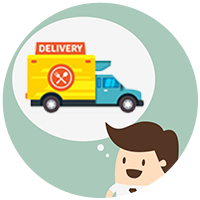MVP Development: How to overcome the challenges?
For an entrepreneur, these golden words by Peter Thiel should ring a bell. While every entrepreneur starts with an aim to become a monopoly one day (just like Google or Facebook), very few reach to that level.
But those who do have always one thing in common: they understand the needs of their customers just like no one else in their market did. And that’s the difficult part of the entire game. Not impossible, but definitely not easy either.
The task of identifying your customer needs

To understand your consumer, you need to start by asking few common questions: what’s the stated (and unstated) need of the customer, does your idea satisfy the customer need, how should you go about validating your idea…and so on.
If you are not asking yourself these questions, there’s a problem.
Albeit, a big one.
Let’s say, you have a concept in mind and you want to evolve it into a fully developed product/service.
Assuming that you are pouring in your life savings and good amount of your time to make this idea work. Won’t you like to maximize your chances of success?
If you dive in right away, without a strategy in mind, there are chances of failure. It is thus even more important to ask the above-mentioned questions to yourself, just to ensure you have set the baby steps before giving final shape to your idea. You should be knowing whether it’s worth doing what you have in mind and taking a calculated risk.
Remember, there’s money and time at stake, and important is that your decisions are driven by logic and rationale than just pure emotion.
And that’s where the concept of Minimum Viable Product (MVP) development comes into the picture.
What is an MVP?
A process that iteratively solves customer pain points by closely connecting and gathering their feedback in the least possible way.

Bill has a passion for baking cakes and wants to pursue this hobby as a full-time business. He is already aware of the popular local cake shops and the kind of cut-throat competition he is likely to encounter if he starts a similar business.
Bill looks around and notices that his friend Tina is a health freak. She loves cakes, but never eats one because she can’t find ‘healthy’ cakes.
Bill puts on his thinking hat and wonders whether there are more people like Tina who need a healthy cake. In other words, what if he bakes cakes for a very specific target audience – the diet conscious?
No doubt the customer base is narrow, but it can result in high popularity of his cakes in that niche, and definitely there’s less competition in healthy cakes.
Well, he is still not sure…
Bill is an enterprising person, and he decides to experiment. He bakes a simple vanilla flavored cake with egg whites and very less icing, records an explainer video, uploads it on YouTube with his phone number and markets the link in his social circle.
His unique proposition here is – Healthy cakes. Well, he starts receiving enquiries, and few orders as well.
In the entire process, one thing catches Bill’s attention. A significant number of people ask him for the exact nutrition value associated with the recipe. He takes this feedback into consideration and uploads the next recipe that explained nutritive value of his vanilla flavored cake and promised to add this to the packaging.
As more feedback came in, Bill realized, more and more of people have a taste for chocolate than vanilla. So, he starts a range of mixed flavors of vanilla and chocolate.
As the business grew, by now, Bill had known, what his customer segment want and how he could deliver the best healthy cakes in his locality.
If you have read this so far, you now have an understanding of what a minimum viable product is.
Here’s a formal definition of an MVP by Eric Ries:
In Bill’s case,
However, there is a confusion that might be tricking your brains now.
How is an MVP different from a POC or a Prototype?
Simply put, a POC or Proof of Concept is the simplest way to verify whether the underlying basis of your idea is viable or not. The proof does not need to be a working model. It can be the first step to research on the feasibility of your idea.
On the other hand, a Prototype is a working dummy of the concept. It might not be the whole product but it outlines the idea and the working of a product.
Also,
A simple, less calorie cake that he might have asked his friends for tasting: Prototype
The healthy vanilla cake sold to consumers for feedback: MVP
Moving on…
Everyone is not as lucky as Bill.
When you start working on your MVP, you face several challenges. Let’s discuss few of them:
(For explaining these, we will be biding good bye to Bill here and let’s say hi to Chris – an entrepreneur planning to build an app for vegan food ordering.)
1. Misinterpreting minimum viability
Most entrepreneurs misunderstand this concept which is partially mislead by the name itself.
It is most definitely not minimal features!
Minimum viability is the least possible way to meet the market need with a useful output. It involves iterations to reach a whole product.
Building a mockup is not an MVP.
Building a website with minimum features is not an MVP either.
Confused? We bet you are.
Taking the example of Chris:

Chris has been planning to start a business that delivers vegan food on demand. Like most startup owners, as we assume in this case, Chris is not aware of what’s the minimal viable resource for him to launch. So, he starts off with a desktop site that just takes vegan food orders.
What’s wrong here?
- What if the product does not solve any consumer problem? – In this case – it’s not sharing the nutritive value of the food ordered and how it benefits them.
- There was no research involved at all – for instance, what is vegan food exactly?
Rather than focusing on the viability of the product for oneself, MVP should be developed with a broader perspective by keeping customers at the center of this approach.
When you figure out the approach, don’t forget to cross-check the risks involved – which brings us to the next most common challenge:
2. Assuming the risk

We’d like to quote lines by Yevgeniy (Jim) Brikman’s article on MVP as a process here:
Whether you’re building a product, writing code, or coming up with a marketing plan, you should always be asking yourself two questions:
- What is my riskiest assumption?
- What is the smallest experiment I can do to test this assumption?
Most startups fail to assume their risk. The only way to find out the risky areas is to test your assumptions. There can be tons of risks that could be involved with the MVP you plan to build. Identify them and make sure you don’t start off with eyes closed.
It is thus important to make the right assumptions for the following:

Your product shouldn’t be beating around the bush solving a problem that doesn’t even exist. This way, you are taking a big risk not even knowing if your solution is solving the right purpose.

Researching your market needs is not a bad idea though! Launching a minimum viable product without laying the basis of a robust business model is another risk that you might be taking.

Building for a market that’s too broad is a risk. Target the right set of early adopters that would be interested to avail the services your product has to offer. Also, keep in mind the difference between people who actually like your product and those who are willing to pay for it or even use it.

Chris invests months of development effort and time towards building a website for the health-conscious consumer. But what if:
- Most consumers spend time on their smartphone instead of a desktop/laptop?
- What if people don’t consider the menu healthy, or are not aware of what vegan food is and have other preferences per se.
- On top of all, what if the city he is delivering to does not have many vegans?
He incorrectly assumed his audience to be sizeable in number, who would love the menu offered by his website.
What do you learn here?
Rather than building an MVP as a product, reconsider building it as a process. A process to learn if your assumptions are viable and build an iteration on the most viable assumptions.
In other words, we suggest Chris to conduct a survey or pull some data that would have updated him about the market scenario.
Which makes us jump to the next challenge:
3. Relationship building

While you can spend your investment on getting the code running soon enough to realize that it wasn’t needed, you can instead utilize this time to gather customer experiences, their choices and challenges.
A successful entrepreneur is good at connecting with people.
Very often, entrepreneurs skip this part and when the feedback pours in, they realize the initial investment was just not worth it!
Since the MVP you are building is meant to solve people’s problems and not yours, give an ear to them and process this useful data as an input for a successful iteration.
By now, Chris is fairly sorted with the needs of his audience, but there are still more challenges to sort.
4. Figuring out the timelines & pricing

As suggested, MVP is a process and is typically iterative. It’s not the final product.
To deliver real value, startupreneurs are overwhelmed and mostly digressed in approach. They burn the midnight oil for some months and voila – are they finished?
Let’s get real here. A minimum viable product is unfinished business until it stabilizes and is accepted.
The best way to work around this conundrum is come to light with the fact that good products don’t launch overnight. The only way you could predict the timelines and costs partially would be through:
- Making informed decisions as per the data available so as to decide the features to roll out with your MVP.
- Outlining a development process that restricts your timelines or in a way is suggestive of a tentative timeline.
- Estimating your team’s turn around time to a prospective challenge or a complex feature you are trying to build.
- Opting for a pricing model that supports MVP development seamlessly. For instance, startups who wish to outsource their technology needs, can choose from a variety of IT pricing models to get started with.
Our friend Chris should know that he couldn’t launch an MVP with one-time development of a website that eventually turns out to be a failure– which brings us face to face with the next challenge:
5. Assuming your fallout options
What’s your plan of action if your MVP fails to impress customers?
Sometimes entrepreneurs have no answer to this question.
He did not do his initial market research and ended up choosing the wrong technology.
He outsourced to the wrong development team to drive the project since they lacked the experience to suggest what’s best for his project. (Choose them wisely – they can make or break it!). We recommend you should ask the right questions to your tech provider before zeroing them down.
And instead end up lurking about how the idea went down the drain, your next should be to brainstorm the following:
- Figure out what went wrong in the very first place? Did your risk assumptions backfired?
- Or was it the marketing effort that lagged?
- Was your development team inexperienced?
- Are your thoughts in line with the lean approach?
- Did you skip prototyping your idea?
- Have you taken consumer feedback seriously?
Try doing this activity and then figure out a possible solution. Keep a plan B in the back of your mind – Always!
6. Having hordes of competition

Too much competition in your target market is not too good for your business. This is one of the major challenges that every founder faces and just cannot be ruled out. However, you can start from a very small niche.
He chose the sub-category on-demand food ordering which narrowed down his competitors list to 10 in his locality.
He further chose the sub-sub-category vegan food ordering which turned to have only 1 existing chain in that area.
This is a way to tackle competition without having it affect your business. It in-fact narrows down to a much-targeted audience that will be all the more interested in a specific category of the product.
And your chances of getting found on search engines would be comparatively higher in this case too. So, rule out any competition by choosing an affinity category that can become early adopters easily.
In fact, sometimes competition is good idea. And all you got to do is challenge the challenges. If you believe your value proposition and product can do wonders than the existing players, it surely will.
Surprisingly, your roadblocks aren’t clear yet. And here comes the next one:
7. Deciding the time of launch
You are done with building the first cut and are ready to roll out your MVP to the consumers. But, one of the major hiccups with launch is the D-Day. There can be several factors that might have a positive or a negative impact on your MVP launch.
Here are a few quick tips to manage a successful launch:
- Adopt an agile approach towards your MVP.
- Stay informed about external factors like – market mood, environmental factors, disasters and any other speculated reasons that can cause a change in the market scenario.
- Announce a pre-launch website or a campaign to notify and sign up potential customers way ahead of time.
- Keep a buffer for unexpected delays in development cycle.
- To be able to launch as per the plan, Chris should start building a brand on social media that signs up for a free diet chart.
- He should keep a tap of external factors like a similar retail store opening just around the time of his launch or before that.
By now, you might have an idea of how to get an MVP built and the right approach to overcome the challenges faced by startup owners.
It’s not just about – build, gather feedback, measure, amend and pivot. All you need to know is, building an MVP does not only involve development, it is an amalgamation of various processes in tandem against the challenges upfront.
Here’s our version for this solution:
Recognize problems + Overcome them + Right approach = Successful minimum viable product (that has maximum acceptance)
Do you face any other challenge other than the ones we listed? Share your experience with us!


